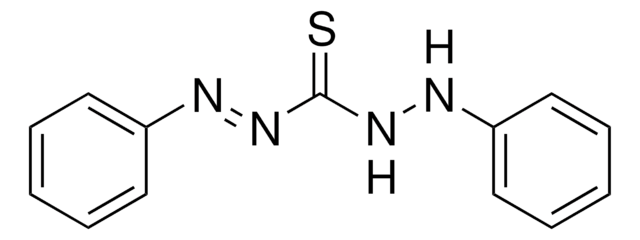15338
Lead(II) oxide
puriss. p.a., ≥99.0% (KT), yellow
About This Item
Recommended Products
vapor pressure
10 mmHg ( 0 °C)
Quality Level
grade
puriss. p.a.
assay
≥99.0% (KT)
form
powder
impurities
≤0.001% total nitrogen (N)
color
yellow
pH
9.9 (20 °C, 100 g/L)
mp
886 °C (lit.)
anion traces
chloride (Cl-): ≤20 mg/kg
cation traces
Ca: ≤10 mg/kg
Cd: ≤5 mg/kg
Co: ≤5 mg/kg
Cr: ≤5 mg/kg
Cu: ≤5 mg/kg
Fe: ≤10 mg/kg
K: ≤50 mg/kg
Mg: ≤5 mg/kg
Mn: ≤5 mg/kg
Na: ≤50 mg/kg
Ni: ≤5 mg/kg
Zn: ≤5 mg/kg
SMILES string
O=[PbH2]
InChI
1S/O.Pb
InChI key
YEXPOXQUZXUXJW-UHFFFAOYSA-N
Looking for similar products? Visit Product Comparison Guide
Related Categories
General description
Lead(II) oxide is a crystalline solid, which can be prepared by decomposition of lead carbonate or by heating molten lead in the presence of air. It can be used in the synthesis of lead(II) ethanoate by reaction with ethanoic acid.
signalword
Danger
Hazard Classifications
Acute Tox. 4 Inhalation - Acute Tox. 4 Oral - Aquatic Acute 1 - Aquatic Chronic 1 - Carc. 2 - Lact. - Repr. 1A - STOT RE 1
target_organs
Central nervous system,Kidney,Blood
Storage Class
6.1D - Non-combustible acute toxic Cat.3 / toxic hazardous materials or hazardous materials causing chronic effects
wgk_germany
WGK 3
flash_point_f
Not applicable
flash_point_c
Not applicable
Certificates of Analysis (COA)
Search for Certificates of Analysis (COA) by entering the products Lot/Batch Number. Lot and Batch Numbers can be found on a product’s label following the words ‘Lot’ or ‘Batch’.
Already Own This Product?
Find documentation for the products that you have recently purchased in the Document Library.
Customers Also Viewed
Our team of scientists has experience in all areas of research including Life Science, Material Science, Chemical Synthesis, Chromatography, Analytical and many others.
Contact Technical Service













